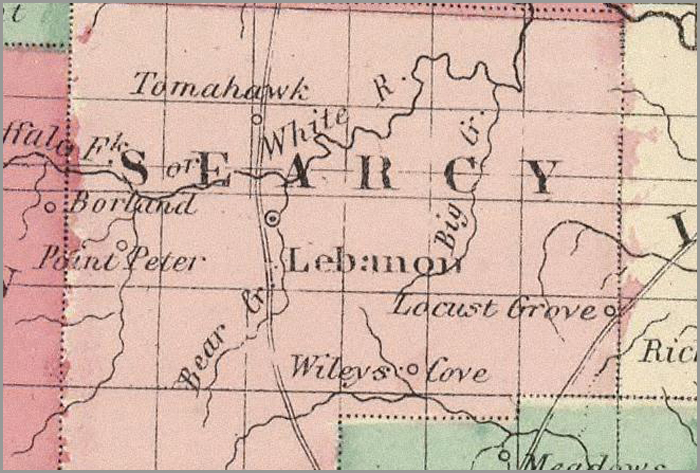Searcy County, Arkansas

- Formed: December 13, 1838
- County Population 1860: 5,178
- Slave Population 1860: 93
– Suffered constant guerrilla warfare
– Burning of Burrowsville, January 1864
Image courtesy of the David Rumsey Historical Map Collection
Searcy County, Arkansas, was originally the territory of the Cherokee, Shawnee, and Delaware Native American tribes. White settlement began in the early 1830s. One of the first white settlers was Charles Saunders, who settled near Bear Creek in 1834 and who would later become a State Senator. The county is located in the Boston Mountains, and contains portions of the White River and Buffalo River.
Searcy County was officially established on December 13, 1838 from parts of Madison and Marion Counties. It was named after a pioneer called Richard Searcy. The county seat was established at James Eagan’s home until it was permanently established at Lebanon, later renamed Marshall, the current county seat of Searcy County. The population grew steadily: in 1840 there were 936 people, 1850 there were 1,979 people, and in 1860 the population was 5,271 people.
When the Civil War began in 1861, most residents sympathized with the Confederacy, though quite a few disagreed with the state’s choice to secede from the Union. The Confederate army quickly raised two military regiments in the county by the end of October, 1861. Many residents did not want to be involved on either side of war, and formed the Peace Society in an effort to remain neutral. Many members of this organization were arrested and forced to fight in the Confederate army.
Searcy County did not suffer any long troop occupations from either the Confederate or the Union Army. Residents did suffer greatly from guerrilla warfare at the hands of bushwhackers. After the war, reconstruction was aided with the formation of railroad towns Leslie and St. Joe. Commercial lead and zinc mines also opened after the war. Though population growth was slow immediately following the war, it steadily increased from 5,614 people in 1870 to 7,278 people in 1880.













